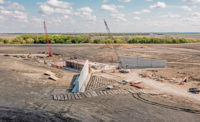Midwest Floods are Hampering River Projects

The Mississippi River has been above flood stage in the Midwest for 39 straight days, a record.
PHOTO BY JEFF YODERS/ENR
The Midwest’s waterways have been hit hard by an unusually rainy and snowy spring. Since March, the Mississippi River has maintained high water levels and crested at near-record levels on May 1. The flooding is also impacting construction operations along the river.
Many Iowa, Illinois, Nebraska and Missouri communities located along the Mississippi and Missouri rivers have all seen high water levels for the last two months. Nebraska Gov. Pete Ricketts announced the state had estimated $1.3 billion in damages after the March flooding there.
On April 30, flood barriers gave way in Davenport, Iowa, where the Mississippi had been above major flood stage for 39 days, a record. Flood waters there had not yet receded and the Mississippi had yet to crest as of this writing. Officials expect the damage in the Davenport a area to remain less severe than what’s been experienced elsewhere.
Only four of the six reservoirs on the Missouri River are designed to impound significant runoff, which was an issue with the March flooding in Nebraska and Iowa. High water levels have contributed to delays for some of the U.S. Army Corps of Engineers’ infrastructure projects along many Midwest rivers including the Missouri and the Mississippi.
Managing Corps Assets
Bridges and Army Corps Buildings in Davenport, Iowa, and other Rock Island District-managed areas were shut down after the flooding there. Maj. Gen. Richard Toy, the commander of the Great Lakes and Ohio River Division, said that the Corps has not been able to dismantle lock and dams 53 and 52, located where the Ohio meets the Mississippi near Olmsted, Ill., as planned. Both antiquated locks were replaced by the Olmsted Locks and Dam last year.
“Removal of wickets from the dam structure at Lock 53 is not planned to begin until the river elevation recedes, which we anticipate near mid-June 2019,” said Corps spokeswoman Katelyn Newton. She added that the Corps’ completion schedule for Phase I (marine portions) of removal of lock and dam 53 is now planned to be completed by the end of November. Demolition work for the marine portions at lock and dam 52 are now anticipated to begin in June 2019 and be completed by December 2020.
At a public meeting of the Mississippi River Commission in Memphis in March, Corps officials said they are still analyzing the data from this spring’s floods to prepare for the future.


